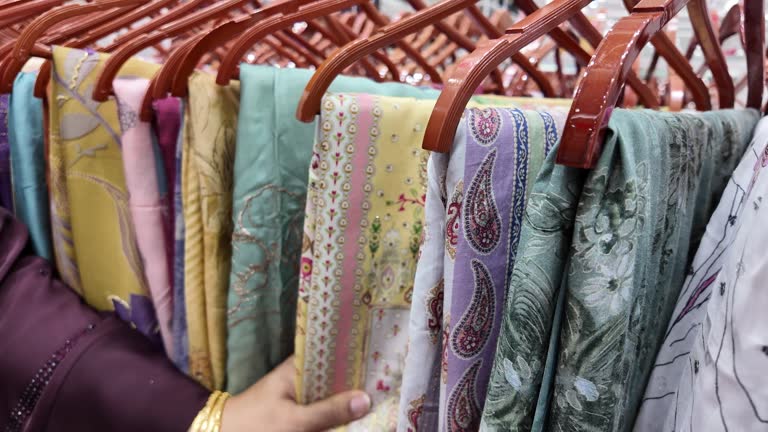Combining traditional craftsmanship with modern design in the art of tailoring Asian Suits, this creates garments having both sophisticated and culturally relevant value. The selection of fabric, which changes with climate, event, and local preferences, is a crucial factor in their unique look and comfort. From silk’s opulent sheen to linen’s sharp durability, every fabric adds special qualities that improve the suit’s drape, breathability, and general appearance. Anyone wishing to buy genuine Asian tailoring or include its classic charm into contemporary wardrobes must first become familiar with these fabric choices. Six often employed fabrics that delineate the quality and character of these elegant clothes are explored in this guide.
Silk
Silk, celebrated for its natural lustre and smooth feel, has been the fabric of choice for expensive Asian formalwear for ages. From Chinese Tang suits to Indian bandhgalas, this breathable, temperature-controlling fabrics may be found everywhere. From shantung sharpness to charmeuse flowing drape traditional weaving method produce different texture. Silk inherent protein structure give it great moisture-wicking qualities and make it hypoallergenic. To maintain rich hand feel while enhancing durability and lowering maintenance demands modern blend frequently combine silk with wool or synthetic fibre.
Cotton
Cotton rules daily suiting across Asia’s warmer areas because of its great breathability and softness. Natural fibres in the fabric provide great air circulation, which makes it suitable for tropical conditions. Suvin cotton from India, a premium long-staple type, provides excellent softness and longevity. Poplin for sharp business suits, twill for structured jackets, and seersucker for airy summer wear all go into various weaves used by tailors. Because it can hold vivid dyes, cotton is ideal for vibrant traditional designs like the Filipino barong Tagalog or the Indonesian batik suit.
Linen
The go-to option for hot and humid conditions, linen adds natural crispness to lightweight suits all around Southeast Asia. Made from flax plant fibers, this loose weave excellent wick moisture off the body while lets great air flow. Linen for official summer use is sometimes featured in Korean hanbok and Vietnamese áo dài. The typical slubbed texture of the fabric adds aesthetic appeal and gets softer with every use. Although pure linen creases readily, several contemporary mixes include silk or cotton to increase wrinkle resistance and keep excellent breathability.
Wool
Wool is the mainstay of conventional tailoring in colder areas such as northern China, Japan, and the Himalayas. Natural temperature control provided by merino wool helps wearers stay cool in summer and warm in winter. The natural elasticity of the fabrics enables form maintenance and comfortable movement. Better grades like super 120s-150s produce lightweight but warm suits ideal for corporate and formal events. Wool’s capacity to retain complex designs makes it perfect for the fine embroidery found in many historical patterns.
Synthetic blends
Modern Asian tailors increasingly use high-tech synthetic blends to improve durability and simplify care. While moisture-wicking fabrics suit urban professionals, polyester-wool blends provide wrinkle resistance for company travellers. Often found in contemporary renditions of classic designs, these performance textiles mix technical qualities with traditional beauty. Still, purists choose natural fibres for their genuine drape and breathability.
Specialty fabrics
Different Asian societies have created distinctive fabrics that define their clothing identity. While Japan’s ramie offers remarkable coolness, India’s khadi (handspun cotton) has cultural importance. Woven from pineapple fibres, the Filipino piña textile produces sheer formal dress. Garments incorporating these speciality materials are especially precious since they frequently need artisanal production techniques handed down over decades.
Brocade
Especially for weddings and official events, Brocade is one of the most visually gorgeous fabrics used in ceremonial Suits. Using gold or silver threads, this highly decorative woven fabric with raised designs creates a sumptuous three-dimensional impression. With designs ranging from floral motifs to complex geometric patterns, Chinese dragon robes and Indian wedding sherwanis include exquisite brocade work. While the metallic threads beautifully capture light during movement, the fabrics great weight lends clothes amazing structure and presence. To keep the classic opulent look but lower costs, contemporary brocades often mix silk with synthetic fibres. Although heavier than other materials, brocade is still unrivalled for producing royal Asian formalwear that has a strong clothing statement.
Conclusion
The variety of materials employed speaks to the many temperatures, cultures, and sartorial customs of the continent. From the opulent drape of silk to the useful comfort of cotton and linen, every fiber has unique qualities that meet various demands and events. Knowing these fabrics possibilities helps one to make more informed decisions when choosing or ordering Asian-inspired suits. Whether one aims for classical authenticity or modern performance, the ideal fabrics helps to realise every idea of Asian tailoring brilliance.
